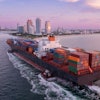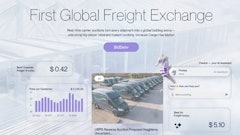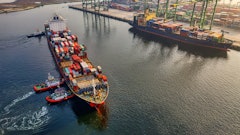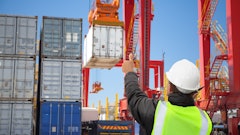VITAL STATS
Bi--national location puts the region in the center of North America’s business community.
Population: 2 million
Land Area: 1,512 square miles
Border Patrol: An international commerce center, accommodating 38 percent of the total trade conducted between the U.S. and Canada.
Telecommunications: Buffalo is one of the most wired cities in the U.S.
Got 20 Minutes? Buffalo is called the "20 minute city" because most points of interest are 20 minutes apart.
Some say the Buffalo, NY, region is in an enviable location. Within an eight--hour drive, you can reach markets catering to 55 percent of the U.S. population and 62 percent of the Canadian population.
“Just to give you an idea of the numbers, the Buffalo--Niagara Gateway between Buffalo and Canada is the second--busiest gateway in the country (Detroit--Windsor being first),” says John Cappellino, director of development for the Erie County Industrial Development Agency.
The Buffalo region has long played a pivotal role in food manufacturing and distribution––all the way back to the grain industry in the 1800s, when Buffalo was one of the country’s largest grain--milling communities. In fact, grain producers today still use barge to transport the commodity. More than 5,200 food companies operate in the Buffalo--Niagara region.
Cappellino is enthusiastic about the benefits for food logistics and distribution operations in the region over the next two decades. "This is an excellent location for serving markets in southern Ontario, New York State, northern Pennsylvania and New England," he says.
Rail and highway accessibility is a top benefit attracting companies considering a food manufacturing or processing operation in the area. In fact, Buffalo’s history as the second--largest rail center in the country at one time means the region supports an excellent rail infrastructure for today’s companies. There’s the CSX, running east--west from the East Coast to Chicago; the Norfolk Southern with major north--south access; and the Canadian National. "We are only one of two points of entry into the Northeast for the Canadian National," Cappellino says.
A number of food facilities in the region are active users of rail and rail--to--truck intermodal. The highway infrastructure includes east--west I--90, a connecting spur to I--95, and U.S. 219. On the Canadian side of the region, the QEW runs right into the Hamilton and Toronto markets.
One of the region’s aggressive projects involves a partnership with the Port Authority of New York and New Jersey. "It’s all about how to package the region as a logistics center and create an inland port in the Buffalo area," explains Cappellino, adding the partnership also includes the Buffalo--Niagara Enterprise and the CSX Railroad.
The new inland port would be used for international container traffic since the Port of New York and New Jersey has just about capped out on dealing with the high volumes of traffic there. The idea would be for international shipments of containers to go right onto a train and arrive in Buffalo as a unit train of up to 200 container cars.
"The CSX is currently building a facility here and they would offload those containers onto cars or local warehouses where they would undergo value--added manufacturing or be stored for distribution at a later time," Cappellino says.
This plan has several advantages. Moving out of New York is a lot quicker with rail than by truck and economies of scale are on the side of moving a train of 200 container cars vs. 200 trucks. "We are also working on getting the port of entry from customs to be considered Buffalo rather than New York so that the containers could clear customs right here in Buffalo," continues Cappellino. "We already have the infrastructure in place to handle these functions with the international freight forwarders and brokers who are already here because of the Canadian border activities." The facility should be ready to operate by late 2005 or early 2006.
Other sites in the immediate area of this new facility are being considered by companies who would locate warehousing and DCs. "Companies would be able to feed markets in an on--time mode and this would work particularly well for consumables and food products," Cappellino says.
Because perishable food goods are coming into the country from all over the world, this facility would help speed up the process from port of entry into a major DC, says Michael Licata, senior business representative for Buffalo--Niagara Enterprise. "When you look at a map of the Buffalo area from a North American perspective, we are really centrally located and more international trade crosses the border in western New York than comes through the Port of New York and New Jersey," Licata says, adding that on a typical day, 300 trucks per hour cross between Buffalo and Canada.
The inland port would be able to handle up to 60,000 containers a year initially. The port will have a network of rail spurs running off the CSX line. Cappellino and Licata say they’ve identified up to 1,0000 acres of land in the vicinity of the facility that could be ready for construction.
Long--term plans for increasing barge traffic on the St. Lawrence Seaway include individual international containers of things like toys for Asia, grapefruits or olives from Italy, all handled by one barge.
As for business incentives companies can expect in the region, there are three major Empire Zones close to the proposed inland port facility. Some benefits within Empire Zones include property tax and sales tax incentives. The region was recently designated as a Federal Renewal Community Zone, which businesses can use for employment tax credits for jobs that are created.
"There are also investment tax credits available through state and federal programs for companies needing to upgrade a production line with new production equipment," Cappellino says. "This can really favorably impact a company’s bottom line in terms of having tax credits to offset corporate profits."
As for after--hours life, the greater Buffalo area offers lots of options––such as major league sports, the Buffalo Philharmonic Orchestra, art galleries, ski areas and world--class sailing on Lake Erie.
------------------------------
Sorrento Cheese
Riding The Rails
Sorrento Cheese, based in Buffalo since 1947, is in a new test mode using rail and so far the company has high praises for its new transportation model. Prior to testing rail services, Sorrento used only truck on the inbound for ingredients and on the outbound for finished goods, says Terry Martin, director of logistics.
"We began using rail to move dry ingredients from Boise to Buffalo because the time constraints are not as stringent with dry products as they are with finished cheese products," Martin says. Rail worked out so well with dry ingredients shipments that the company is now in a test mode shipping cheese by rail. "It’s a definite cost saver and a real benefit for us" he says.
Currently, the test mode shipping finished goods by rail is very favorable so far. "Time lines have been met and we’ve had some very good cost reductions," Martin says. Sorrento is also shipping finished products from its facility in Boise to Buffalo for final distribution to the East Coast.
C.R. England is Sorrento’s total logistics provider. "They have increased their intermodal division and just purchased about 150 trailers for intermodal," continues Martin. "Because of the shortage of capacity in trucking, many companies like us are researching shipping by rail."
Sorrento operates two large DCs––one in Buffalo serving markets on the East Coast and one in Boise serving West Coast markets. Sorrento is a provider of premium Italian cheeses. Its secondary market is making specialty cheeses under the Lactalis (its parent company) brand name, called President. "We are one of the largest producers of domestic brie in the country," says Martin, adding the company also brands gouda and feta cheeses. Lactalis operates five cheese--making facilities and a small DC in New Jersey that distributes to the New York market.















